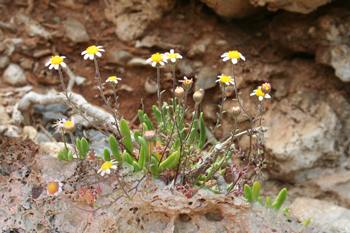Plant diversity in the Mediterranean Basin
 Situated at the intersection of the major landmasses of Eurasia and Africa, the Mediterranean Basin is the largest of the world's five Mediterranean-climate regions, covering more than 2 million km². It has been classified as one of the world's 25 biodiversity hotspots with 25,000 species of plants – one in ten of all known plants on Earth, of which over half are found nowhere else in the world.
Situated at the intersection of the major landmasses of Eurasia and Africa, the Mediterranean Basin is the largest of the world's five Mediterranean-climate regions, covering more than 2 million km². It has been classified as one of the world's 25 biodiversity hotspots with 25,000 species of plants – one in ten of all known plants on Earth, of which over half are found nowhere else in the world.
The Mediterranean Basin is recognised as amongst the four most significantly altered biodiversity hotspots on Earth. Despite its international recognition as a biodiversity hotspot, in 2008 protected areas covered 90,000 km², or 4.3% of the total land area. This leaves much of the Mediterranean flora unprotected from changes in land use associated with economic activity such as tourism and agriculture.
Within the Mediterranean Basin, islands have been identified amongst the "red-alert" areas for plant conservation. These islands are not only extremely rich in endemic plant species but they also contain important areas for nesting and migrating birds and invertebrates. At a local level, important sites are largely recognised in the Natura 2000 network and in Ramsar designations. An example is the Ramsar site Akrotiri in Cyprus which contains Annex 1 habitats and bird species (11 and 45 respectively) as well as 13 plant species of national importance.
The islands of the Mediterranean possess 41% of the coastline giving them a large responsibility for the littoral zone which is comprised of a variety of significant and yet fragile ecosystems such as beaches, dunes, reefs, lagoons, swamps, estuaries and deltas. The islands included in this project also have mountainous regions within them, which provide a rich variety of additional plant habitats. In consequence, the islands contain a wide range of habitats within a small but restricted area, reducing the opportunities for species migration in response to change in any one of the habitats. On this basis, island ecosystems are more fragile than those on larger landmasses.
The specific need for a tailored conservation effort on islands and greater international collaboration has been identified in the report International Efforts to Conserve Biological Diversity on Islands prepared for the Standing Committee of the Bern Convention. IUCN's The Top 50 Mediterranean Islands Plants report highlights an exemplar group of threatened island plant species and underlines that a concerted and focused pan-European conservation effort, particularly within the biodiversity hotspot of the Mediterranean Basin, is urgently needed. This effort needs to include off-site (ex-situ) conservation action to maintain a wide range of options for the future.
The general trends in the Mediterranean are more clearly visible on the islands where the project will be based, including water shortages, tourism development, wild fires and land use changes. The selected islands all contain mountainous regions, which provide topographical diversity, adding to the number of habitats available for plants to colonise, compared to lowland areas.

